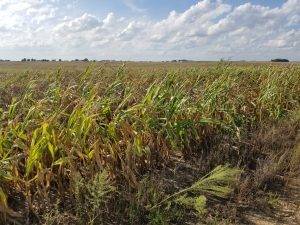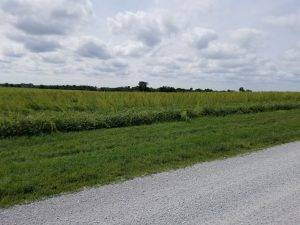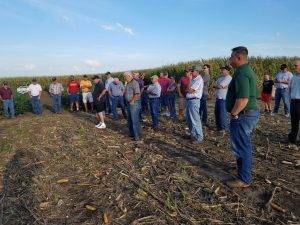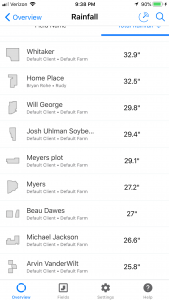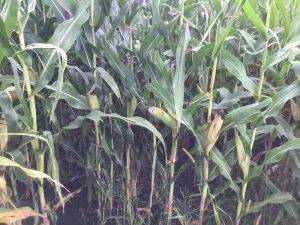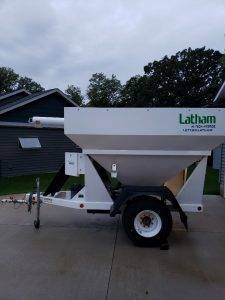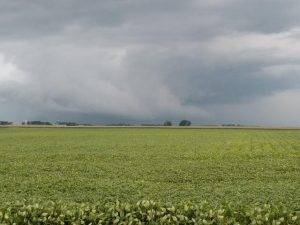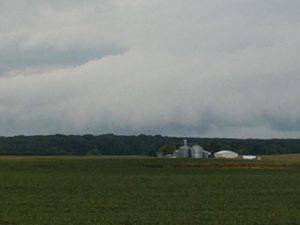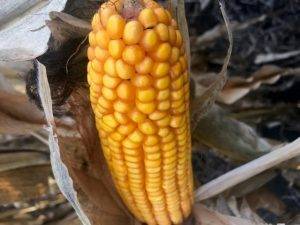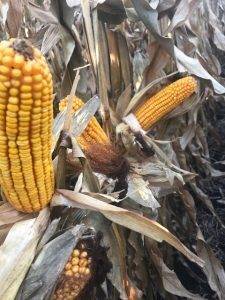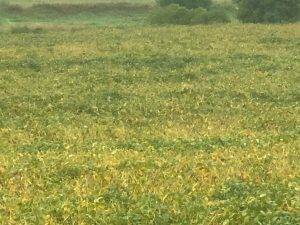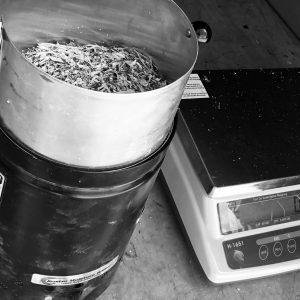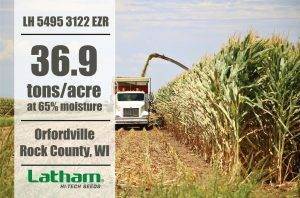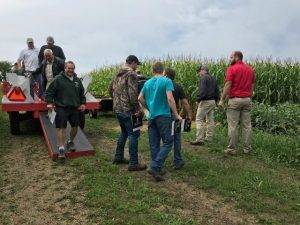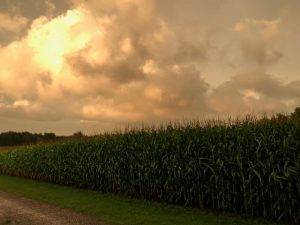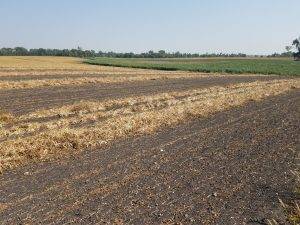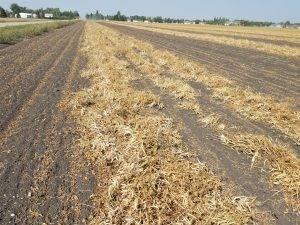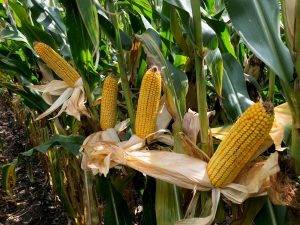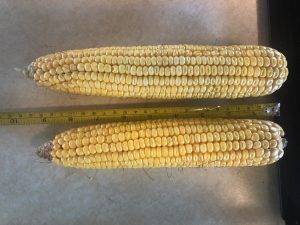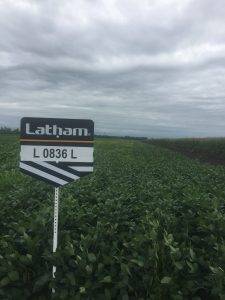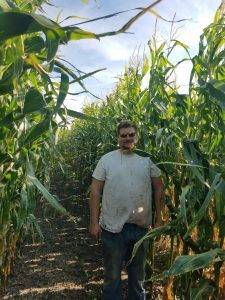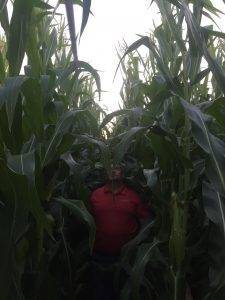EASTERN IOWA
Jerry Broders
Eastern Iowa has received a lot of wind and rain during the past week. The crop continues to mature, and we’re holding plot tours around the region. Remember Latham’s Field Day will be Sept. 14 at the home farm in Alexander. You’re invited to road trip to North Central Iowa!
At Latham Hi‑Tech Seeds, we’re all about options for farmers. Pictured here is a soybean field by Muscatine, Iowa. It is hard to tell if this is soybean or waterhemp field! We have trait options to take care of this issue, so talk to your local Latham® representative for the best choices for your operation.
CENTRAL IOWA
Bryan Rohe
Curious as to how much rain has fallen? Climate FieldView is a very helpful – and free – tool that allows you to check rainfall even when you’re away from your home. Plus, you never have to remember to dump the gauge.
Weather is one of the factors we can’t control. However, this data allows us to track how different hybrids respond to rainfall amounts. It’s one more way we can help select the best seed for each field.
NORTHEAST IOWA & SOUTHEAST MINNESOTA
Craig Haaland
Here is a field of Latham® LH 5099 SS RIB in Mitchell County, Iowa, that was planted corn-on-corn.
Rain, rain and more rain! That’s what Mother Nature has been giving us during the past couple of weeks.
Some areas have received 7 inches in just a few days. We hope fields dry quickly because harvest is inching closer.
WEST NORTH CENTRAL IOWA
Bart Peterson
Last week I got the weigh wagon tuned up and the oil changed. We’re ready for Latham® SuperStrip Plots, co-op plots and side-by-side checks!
NORTH CENTRAL IOWA & SOUTH CENTRAL MINNESOTA
Cory Greiman
We’ve experienced one storm after another. Pictured here are warning clouds and heavy rain near Algona, Iowa.
NORTHWEST IOWA
Darin Chapman
By the looks of the bright orange kernels on these ears, we should be very pleased with the test weight on this Latham LH 5215 VT2 PRO!
It has been raining steadily in Northwest Iowa for the past couple of days, and it’s supposed to continue raining the rest of this week. Hopefully, it stops soon. We don’t need a wet fall to match our wet spring!
WESTERN IOWA & EASTERN NEBRASKA
Larry Krapfl
SOUTHERN WISCONSIN
Greg Mair
Corn silage acres are drying fast. Across southern Wisconsin, we’re seeing about 50% milk line in grain is consistently 63-65% whole plant moisture. We’re also seeing some really great tonnage.
Widespread rain across southern Wisconsin has kept choppers out of the fields this week. Moisture at harvest is key to proper storage and feed quality. Call me if you are interested in a “no strings attached” corn silage moisture test.
While some corn acres are maturing, there are a lot of acres that are showing signs of a new disease in Southern Wisconsin. Tar Spot has been at the forefront of growers’ minds. We are still learning about this disease, but we know that timely harvest will allow you to capture the most yield. Stalk quality may deteriorate very quickly in severely affected acres.
NORTHERN WISCONSIN
Joey Salter
Rain events and storms have been the story for the past week. I didn’t think I would say this, but it can stop raining anytime now. Photos 1 and 2 were taken at Corey Catt’s plot day. Corey did a fantastic job talking about Latham products, and we appreciate all of the farmers who showed up on a rainy day. The last picture was at my house in Fall Creek where I managed to catch some after shots of the storm.
NORTHERN MINNESOTA
Ken Highness
Do you know Americans eat about 8 pounds of beans per person each year? North Dakota ranks first in the nation of all dry edible bean production. Harvest of edible soybeans is underway from the Canadian border to Morris, Minnesota. This is a field of kidney beans near Morris. Crops were stressed throughout this region from too little summer rain. Stalk integrity will be a challenge, so farmers are making harvest management a priority. Be sure to also monitor stalk quality in your corn fields and harvest the worst first.
SOUTHEAST SOUTH DAKOTA
Ramie Coughlin
This photo shows Latham® Liberty soybeans at their finest.
When deciding which trait to use, look at the yield potential for your maturity zone and the trait YOU need to control weeds in YOUR fields. Many people ask me about yield potential on “old” traits verses “new” traits. Each trait group has some excellent products. Newer traits typically are stacked on the newer genetics, but many growers contend there are older soybeans that keep winning the farm year after year. I’ll be glad to meet with you about which products are best for you, field by field.
NORTHEAST SOUTH DAKOTA
James Keltgen
LH 3937 VT2 PRO is nearly to black layer with kernel counts of 20X30 at 32,000.
LH 5175 VT2 PRO DroughGard® at 18,000 is putting on two to three ears at Hermosa, South Dakota.
SOUTHEAST NORTH DAKOTA
Gary Geske
As this year’s crop of soybeans reaches maturity, look at the different varieties you have planted. Some very healthy varieties may stay greener than you thought, so you may need to change your harvest rotation. Keep inspecting corn fields for stalk issues, which may require an earlier harvest.
EASTERN NORTH DAKOTA
Brian McNamee
It’s that time of year when silage testing is in full swing. Initial testing confirms that tonnage per acre will be down across the state, especially in drought-stricken areas. Ear sizes are down considerably due to little to no rain at optimal times. However, we are seeing positive results despite the adverse conditions and moisture limitations as pictures show. As always, Latham’s Leafy hybrids are on the leading edge.

